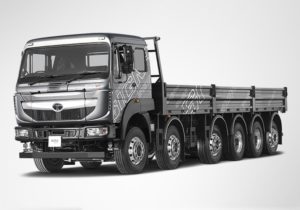Govt raises axle load capacity of trucks & tractor trailers
In a respite to the overloading restrictions on trucks getting stricter day by day, the maximum safe axle weight or in essence the loading capacity for heavy trucks and tractor trailers could be increased by as much as 20-25 percent. This shall bring up the permissible Gross Vehicle Weight (GVW) limits in India at par with those prevalent in developed nations & even beyond in some cases. However, clarity is yet to be come out whether the increased axle loads would apply to only new vehicles manufactured after the statutory norms are enforced or all the existing as well as new trucks. Gross Vehicle Weight (GVW) of a truck is the sum of unladen kerb-weight of the truck plus the payload it can carry.

Some of the take-aways from the notification copy received from industry sources are as under :
- Maximum safe axle weight of a single axle with 2 tyres to be increased from 6 Tons to 7.5 Tons
- Maximum safe axle weight of a single axle with 4 tyres to be increased from 10.2 Tons to 11.5 Tons
- Gross vehicle weight (GVW) of a 2 axle truck to be increased from 16.2 Ton to 19 Tons
- Gross vehicle weight of a current 10 wheeler - 3 axle rigid truck to be increased from 25 tonnes to 28.5 tonnes
- Gross vehicle weight of a current 14 wheeler - 37 Ton GVW rigid truck to be increased to 43.5 tonnes
As per the new norms, the maximum allowable GVW (Gross vehicle weight) for rigid vehicles will get capped at 49 Ton and tractor trailers at 55 Ton. Effect Of Increased Axle Load On Commercial Vehicle Industry in India : The commercial vehicle industry and heavy duty trucks industry especially is likely to witness spurt in demand in case the new norms are applicable only on the new vehicles manufactured after the order is implemented. In case the norms are applicable to the existing trucks also, fleet owners and transporters will have enough increased fleet capacity to carry the available Ton-Kilometers of load. This is going to have serious impact on the current fleet utilization and the demand for enhancing fleet size further. This in turn shall affect demand for new trucks and the subsequent sales figures of CV OEMs like Tata Motors, Ashok Leyland, Eicher Trucks & Buses, Mahindra Trucks negatively. Effect of increased axle load on surging demand for 37 Ton and 49 Ton trucks and tractors: Owing to stricter overloading restrictions, the demand for higher tonnage trucks has been growing leaps and bounds over the past few quarters. The customers for earlier 12 wheeler - 31 Ton GVW rigid trucks (like Tata 3118 or Ashok Leyland 3118) had been moving towards 14 wheeler - 37 Ton GVW trucks (like Tata 3718 or Ashok Leyland 3718). And same way the demand for tractors was shifting towards higher 49 Ton GCW tractor trailers. With the change in axle load norms, the quick upwards shift is likely to taper off. Future of 16 wheeler trucks under testing by Commercial Vehicle manufacturers : Many of our readers would be updated that almost all the CV majors are working day-in-day-out to bring their 16 wheeler rigid truck concepts to the market at the earliest.

Eicher Pro 6041 Truck
While Tata Motors showcased their Tata Signa 4323 truck with 12x2 axle configuration at the auto expo 2018, Ashok Leyland 4123 truck was showcased at the auto major’s Global Dealers Conference at Chennai in last quarter. And overtaking both the market leaders, emerging heavy duty trucks maker Eicher Trucks & Buses (VECV) has launched the Industry first 16 wheeler truck - Eicher Pro 6041 rigid truck with 10x2 axle configuration, same as the current 37 Ton GVW trucks.

Tata Signa 4323.T - 16 Wheeler Rigid Truck In case of increased axle load capacity, the current 37 Ton GVW trucks (14 wheeler trucks) shall be sufficient enough to carry extra loads totalling upto 43 tons GVW, without having to purchase newly conceptualized 16 wheeler rigid trucks. Fitness certificates for medium & heavy trucks would now be renewed every two years for vehicles upto eight years old and once every year for vehicles older than 8 years.